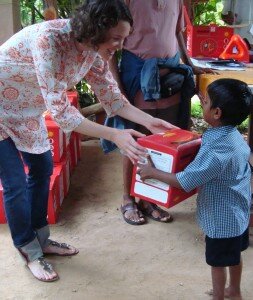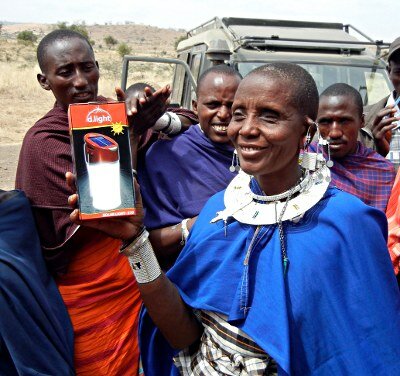Mackenzie O’Donnell recounts her experience as an Ambassador for One Million Lights, bringing solar-powered lights for students in Nepal, in April 2013.
The moment I got off my plane at Tribhuvan International Airport in Kathmandu, it was abundantly apparent I was in a very different place, on account of the smell in the air.
Nepal is a developing country located north of India and south of Tibet and is the home of the massive geological feature that is the Himalayas. Its people, 30 million strong, are proud and hard-working, with a natural openness in their faces which inspires hope.
This was my first visit to this part of the world. I had carefully detailed my logistics, fundraising efforts and distribution plans to bring 282 solar lanterns to students and families in need for almost nine months.
For the One Million Lights (OML) Global Ambassador Program distributions around the world we try to focus on bringing solar lights to kerosene dependent communities so students can do their homework at night and households can light their homes without fire hazards. In Nepal, consistent electricity access is scarce, with scheduled rolling blackouts throughout the day for the entire country. A young woman, Sharon Lou, reached out to me in August 2012 about sending lanterns with an upcoming visit from a team of doctors who visit the students at the Shree Mangal Dvip schools annually to provide services as an aspect of volunteerism. After logistics didn’t pan out for the team of doctors, I made a decision to go there myself and claim an adventure for the cause. I have been a volunteer with OML for four years now, helping spread awareness about the levels of kerosene-dependence around the world in the San Francisco Bay Area and in Washington DC for several years.
 Over several months, Sharon helped me select and communicate with the two schools receiving the lights, namely Shirley Blair. Shirley is an exquisite woman who leads the Shree Mangal Dvip school; I raised funds with the help of several students at nearby California High School in San Ramon, California; students at Egan Junior High School in Palo Alto, California: and friends and family who supported my endeavors. I purchased my flights, kept working as often as possible to put funding towards the lights and geared up mentally and physically for the experience. The morning I was to leave for Nepal, nothing short of a heart attack or broken leg could stop me.
Over several months, Sharon helped me select and communicate with the two schools receiving the lights, namely Shirley Blair. Shirley is an exquisite woman who leads the Shree Mangal Dvip school; I raised funds with the help of several students at nearby California High School in San Ramon, California; students at Egan Junior High School in Palo Alto, California: and friends and family who supported my endeavors. I purchased my flights, kept working as often as possible to put funding towards the lights and geared up mentally and physically for the experience. The morning I was to leave for Nepal, nothing short of a heart attack or broken leg could stop me.
 I visited the Shree Mangal Dvip School in Kathmandu the day after my arrival, meeting children who would receive the lights on distribution day. These students, between the ages of 4-14 years, all had developed a passion for science and mathematics, medicine and physics. Despite hardships, somehow this school is getting by with the help of donors, luck, and a lot of hard work. For the following 11 days I went on a trek through the Annapurna region in an attempt to discover as much of the country as possible while I was there. When I returned I visited the second school, a Buddhist monastery in Namo Buddha, about two hours outside of Kathmandu. At the monastery school 500 young monks lead relatively simple lives, praying and meditating every day for several hours and utilizing as much access to technology as possible to further their studies. There is also a small free health clinic running through the monastery for the people living in the local hills. The two proprietors of the health clinic were from the United States and had a greater vision for health in developing regions, and I was drawn to them.
I visited the Shree Mangal Dvip School in Kathmandu the day after my arrival, meeting children who would receive the lights on distribution day. These students, between the ages of 4-14 years, all had developed a passion for science and mathematics, medicine and physics. Despite hardships, somehow this school is getting by with the help of donors, luck, and a lot of hard work. For the following 11 days I went on a trek through the Annapurna region in an attempt to discover as much of the country as possible while I was there. When I returned I visited the second school, a Buddhist monastery in Namo Buddha, about two hours outside of Kathmandu. At the monastery school 500 young monks lead relatively simple lives, praying and meditating every day for several hours and utilizing as much access to technology as possible to further their studies. There is also a small free health clinic running through the monastery for the people living in the local hills. The two proprietors of the health clinic were from the United States and had a greater vision for health in developing regions, and I was drawn to them.
Before I left the Monastery I distributed 48 Nokero solar light blubs to the health clinic for distribution to the people living in the town. I know they will be put to excellent use. The remaining 234 DLight lanterns were distributed to the students at the two branch schools in Namo Buddha and in Bouddha, Kathmandu, and we will be able to help these students push forward in their education for years to come, regardless of rolling blackouts!
One monk I met, Pemzi Tsering, is 10 years old and lives at the Namo Buddha Monastery. He was very grateful for receiving the solar light because he is interested in learning about medicine and becoming a doctor one day. Now, he says, with the help of the solar lantern, he can keep studying and pursue both of his life passions.
- Mackenzie O’Donnell, June 2013








